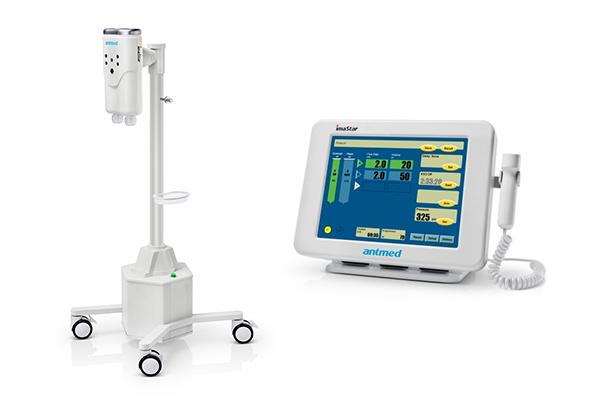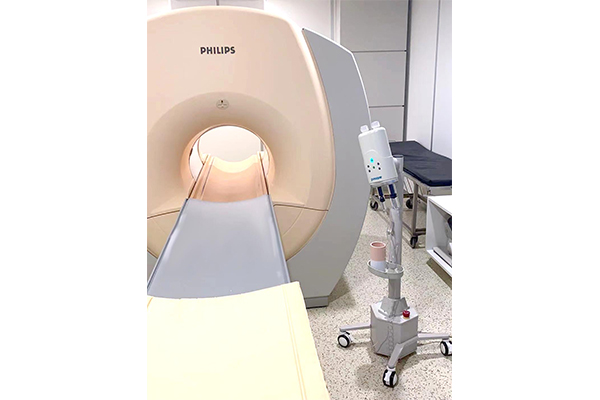Compared with traditional manual injector, high pressure injector has the advantages of automation, accuracy and so on. It has gradually replaced manual injection method and become one of the necessary equipment for magnetic resonance (MR) enhanced scanning. This requires us to master its operating technology in order to perform well in the process.
1 Clinical operation
1.1 General purpose: Enhanced MR scanning for diseases includes tumors, suspected of space occupying lesions or vascular diseases.
1.2 Equipment and drugs: High pressure injector used by our department is the ImaStar MDP MR injector produced by Antmed. It is composed of injection head, host computer and console with a display touch screen. The contrast agent is domestic and imported. The MR machine is a 3.0T superconducting whole body MR scanner produced by PHILIPS Company.
Shenzhen Antmed Co., Ltd. ImaStar MRI Dual Head Contrast Media Delivery System:
1.3 Operation method: Turn on the power supply, place the power switch on the right side of the operating room component in the ON position. After the self-inspection of the machine is completed, if the indicator flicker meter is in the ready-for-injection state, install the MR high-pressure syringe produced by Antmed], with A syringe, B syringe and T connecting tube attached inside. Under strict aseptic operation conditions, turn the injector head upward, unscrew the protective cover on the tip of the syringe, Click the forward button to push the piston to the bottom, and draw 30~45 ml of contrast agent from the “A” tube, and the amount of normal saline from the “B” tube is equal to or greater than the amount of contrast agent. During this process, pay attention to expell the air in the syringe, connecting the T connecting tube and needle, and conduct venous puncture after exhausting. For adults, inject 0.2~0.4 ml/kg of contrast agent, and for children, inject 0.2~3 ml/kg of contrast agent. The injection speed is 2~3 ml/s, and all of them are injected into the elbow vein. After successful venous puncture, Open the KVO (keep vein open) on the home page of the screen to prevent blood blockage, ask the patient’s reaction, carefully observe the patient’s reaction to the drug, eliminate the patient’s fear, then carefully send the patient into the magnet to the original position, cooperate with the operator, inject contrast agent first, then inject normal saline, and scan immediately. After scanning, all patients should stay for 30 minutes to observe whether there is any allergic reaction before leaving.
2 Results
The successful puncture and drug injection enable the MR enhanced scanning examination to be successfully completed according to the scheduled plan, and obtain the imaging examination results with diagnostic value.
3 Discussion
3.1 Advantages of high pressure injector: The high pressure injector is specially designed for injection of contrast agent during MR and CT enhanced scanning. It is controlled by a computer with high degree of automation, accuracy and reliability, and flexible injection mode. The injection speed, injection dose, and observation scanning delay time can be set according to the needs of the examination.
3.2 Nursing precautions for using high-pressure injector
3.2.1 Psychological nursing: Before the examination, first introduce the examination process and possible situations to the patient, so as to relieve their tension, and let the patient be prepared psychologically and physiologically to cooperate with the examination.
3.2.2 Selection of blood vessels: The high pressure injector has high pressure and fast injection speed, so it is necessary to select thick, straight veins with sufficient blood volume and good elasticity that are not easy to leak. The veins at joints, venous sinuses, vascular bifurcations, etc. should be avoided. The commonly used veins are the dorsal hand vein, the superficial forearm vein, and the median elbow vein. For the elderly, those with long-term chemotherapy and serious vascular injury, we mostly choose to inject drugs through femoral vein.
3.2.3 Allergic reaction prevention: As MR contrast medium is safer than CT contrast medium, allergy test is generally not conducted, and preventive medicine is not required. Very few patients have nausea, vomiting, headache and fever at the injection site. Therefore, it is necessary to ask the patient’s allergy history and condition for patient cooperation. Emergency medicine is always available, just in case. After enhanced scanning, each patient is left for observation for 30 minutes without adverse reactions.
3.2.4 Prevention of air embolism: Air embolism can lead to serious complications or even death of patients, which must be handled with caution. Therefore, the operator’s carefulness, vigilance and standardized operation are the fundamental guarantee to reduce the air embolism to the minimum possibility. When pumping contrast agents, the injector head should be upward so that bubbles can accumulate at the tapered end of the syringe for easy removal, When injecting, the injector head should be downward so that small bubbles float on the liquid and are located at the end of the syringe.
3.2.5 Treatment of contrast medium leakage: If the contrast medium leakage is not properly treated, it may cause local necrosis and other serious consequences. Minor leakage may not be treated or 50% magnesium sulfate solution shall be used for local wet compress after the needle eye is closed. For severe leakage, the limb on the leaking side must be lifted first, and then 0.25% Procaine shall be used for local ring sealing, and 50% magnesium sulfate solution shall be used for local wet compress. The patient shall be told not to use local hot compress, and it can recover to normal in about a week.
For more information about our products and services, please contact us at info@antmed.com.
Post time: Dec-08-2022



